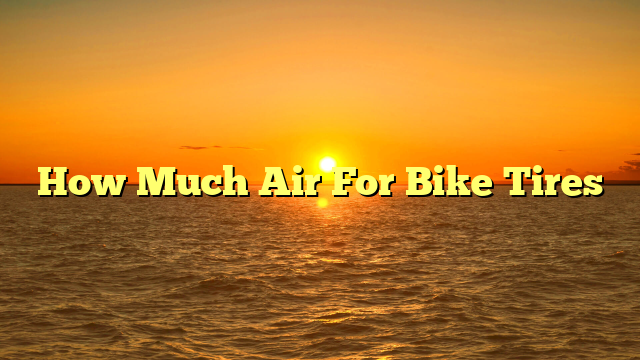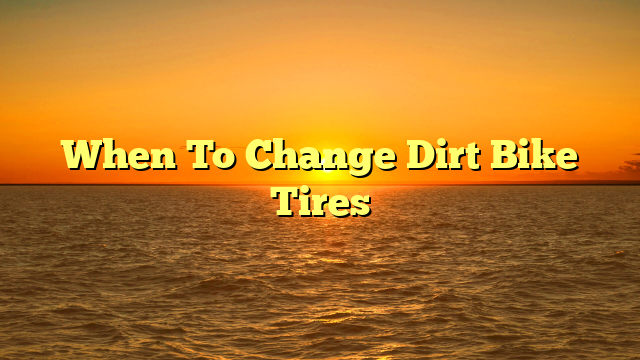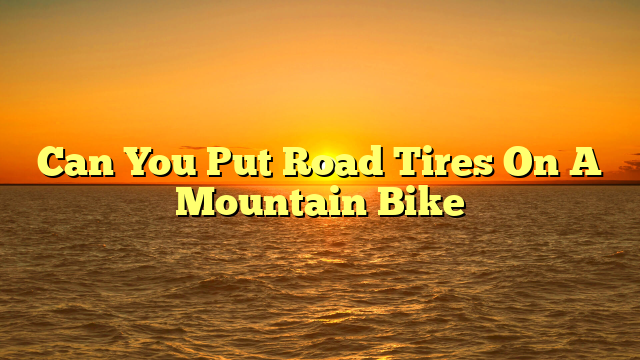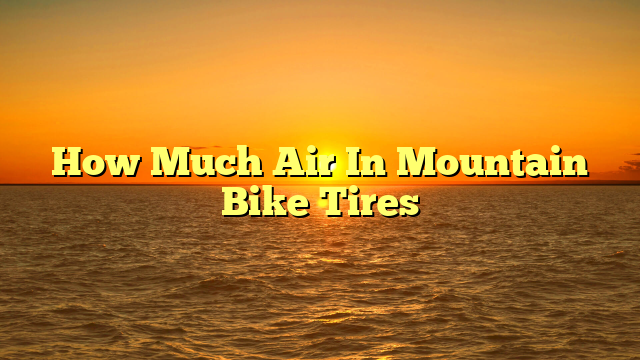Properly inflated tires are vital for the optimal performance of any bicycle.
A bike with underinflated tires requires more effort to ride and is slower, while overinflated tires can make riding uncomfortable and increase the risk of a tire blowout.
Therefore, knowing how much air to put in bike tires is crucial for any cyclist, regardless of their level of expertise.
The ideal tire pressure for a bike depends on several factors, including the type of bike, the type of tire, and the rider’s weight.
Failing to maintain the correct tire pressure can lead to reduced efficiency, decreased handling, and increased risk of accidents.
In this article, we will discuss the importance of properly inflated tires for bike performance, the recommended tire pressure for different types of bikes and tires, and how to check and maintain the proper tire pressure to ensure long-term bike health.
Table of Contents
- 1 Key Takeaways
- 2 Importance of Properly Inflated Tires for Bike Performance
- 3 Types of Bikes and Their Recommended Tire Pressure
- 4 Types of Tires and Their Ideal Inflation Levels
- 5 How Rider Weight Affects Tire Pressure
- 6 Tools Needed for Checking and Inflating Tires
- 7 How to Check Tire Pressure and Inflate Tires
- 8 Signs of Underinflated or Overinflated Tires
- 9 Maintaining Proper Tire Pressure for Long-Term Bike Health
- 10 Frequently Asked Questions
- 10.1 Can I use a regular pump to inflate my bike tires or do I need a special one?
- 10.2 Is it okay to inflate my tires to the maximum pressure stated on the tire?
- 10.3 How often should I check my tire pressure?
- 10.4 What should I do if I don’t have access to a tire pressure gauge?
- 10.5 Can I ride my bike with slightly underinflated tires or will it cause damage to my bike?
- 11 Conclusion
Key Takeaways
- The ideal tire pressure for a bike depends on several factors such as tire width, intended use, and rider weight.
- Different types of bicycles have specific recommended tire pressures based on their features.
- Checking tire pressure should be done before every ride using a tire pressure gauge and an air pump.
- Proper tire inflation not only improves bike performance but also increases the lifespan of the tire, ensuring a safe and comfortable ride.
Importance of Properly Inflated Tires for Bike Performance
The optimal inflation pressure of bike tires plays a critical role in achieving maximum performance, as it affects rolling resistance, handling, and overall comfort of the rider.
Properly inflated tires are essential for efficient riding, as underinflated tires increase rolling resistance, making it harder to pedal and decreasing speed, while overinflated tires reduce traction and control, increasing the risk of skidding and loss of control.
Additionally, the correct pressure ensures that the tire’s contact patch is evenly distributed, providing better stability and handling.
There are various methods for properly inflating bike tires, including using a floor pump with a gauge, a hand pump with a gauge, or a compressed air source at a gas station or bike shop.
It is crucial to check the manufacturer’s recommended pressure range, usually indicated on the sidewall of the tire, and adjust accordingly.
It is also essential to inspect the tire for any signs of damage or wear and replace if necessary.
Proper tire inflation not only improves bike performance but also increases the lifespan of the tire, ensuring a safe and comfortable ride.
Types of Bikes and Their Recommended Tire Pressure
Different types of bicycles have specifically recommended tire pressures based on factors such as tire width and intended use, which can greatly affect their performance and safety.
Road bikes typically have narrower tires and require higher pressure to reduce rolling resistance and increase speed.
The recommended tire pressure for road bikes typically ranges from 80 to 130 psi.
On the other hand, mountain bikes require lower tire pressure to improve traction and absorb shock on rough terrains.
The recommended tire pressure for mountain bikes ranges from 30 to 50 psi.
In addition to tire width and intended use, the type of tire system used also affects the recommended tire pressure.
Bikes can have either tube or tubeless tires.
Tubeless tires, which are becoming increasingly popular, use a sealant to prevent punctures and eliminate the need for an inner tube.
They require lower tire pressure compared to tube tires.
In general, tubeless tires require 5 to 10 psi less than tube tires.
When inflating tires, it is important to follow the manufacturer’s recommendations to ensure optimal performance and safety.
Types of Tires and Their Ideal Inflation Levels
Various types of bicycles require specific tire pressure based on factors such as tire width, intended use, and tire system used.
When it comes to tire systems, the two most common types are tube and tubeless.
A tube is a separate component that is placed inside the tire and inflated to create pressure.
On the other hand, tubeless tires are designed to create an airtight seal with the rim of the wheel, eliminating the need for a separate tube.
The ideal inflation level for tubeless tires is generally lower than that of traditional tube tires, as they rely on the tire’s sidewalls for support.
In contrast, tube tires require higher inflation levels to maintain their shape and prevent pinch flats.
Another factor that affects tire pressure is temperature.
As the air heats up, it expands, which can cause an increase in tire pressure.
Conversely, as the air cools down, it contracts, leading to a decrease in tire pressure.
This means that tire pressure can fluctuate depending on the temperature of the environment in which the bike is being used.
Therefore, it is important to check tire pressure regularly and adjust it as necessary to ensure optimal performance and safety.
By taking into account the type of tire system and the effect of temperature on tire pressure, cyclists can determine the ideal inflation level for their specific bike and tire combination.
How Rider Weight Affects Tire Pressure
Cyclists should consider their body weight when determining the appropriate tire pressure for their bikes.
Rider weight and tire pressure are interrelated, and finding the right balance can enhance the bike’s overall performance.
When a cyclist chooses a tire pressure that is too low, the tire will compress under their weight, making the bike harder to pedal.
On the other hand, if the tire pressure is too high, the bike will feel rigid and unstable, especially on uneven terrains.
Weather conditions also affect tire pressure on different terrains.
For instance, riding in hot weather can cause the air in the tire to expand, leading to increased pressure, while riding in cold weather can cause the air to contract, reducing the tire pressure.
Additionally, different terrains require different tire pressures.
For example, off-road tires need lower pressure than road tires to provide better grip and absorb shocks.
Therefore, cyclists should consider their weight, weather conditions, and terrain when determining the appropriate tire pressure for their bikes to have a more comfortable and efficient riding experience.
Tools Needed for Checking and Inflating Tires
Essential tools are required for cyclists to accurately check and adjust the tire pressure of their bicycle.
The two most important tools for this task are a tire pressure gauge and an air pump.
A tire pressure gauge is used to measure the amount of air pressure in the tire, while an air pump is used to inflate the tire to the desired pressure.
When selecting a tire pressure gauge, it is important to choose one that is accurate and easy to use.
There are two main types of tire pressure gauges: digital and analog.
Digital gauges are more precise and easy to read, while analog gauges are simpler and less expensive.
When choosing an air pump, it is important to consider the type of valve on the bike tire.
Most modern bikes use either a Presta or Schrader valve.
Some air pumps have adapters to fit both types of valves, while others are specifically designed for one type.
It is also important to choose an air pump that is easy to use and has a gauge to monitor the amount of air being pumped into the tire.
With the right tools, cyclists can ensure that their bike tires are inflated to the correct pressure, improving performance and safety on the road.
How to Check Tire Pressure and Inflate Tires
To accurately measure and adjust tire pressure, one should first locate a reliable tire pressure gauge and air pump.
It is important to use a gauge specifically designed for bike tires, as car tire gauges may not provide accurate readings for the lower pressure of bike tires.
Checking tire pressure should be done before every ride, as tire pressure can decrease over time and affect the bike’s performance and safety.
To check tire pressure, remove the valve cap and press the gauge onto the valve stem to get a reading.
The recommended tire pressure can be found on the sidewall of the tire or in the bike manual.
Use the air pump to inflate the tire to the recommended pressure, making sure to not overinflate the tire.
Common mistakes include using an inaccurate gauge, not checking tire pressure before every ride, and overinflating the tire, which can cause it to burst.
By checking and adjusting tire pressure regularly, cyclists can ensure optimal performance and safety while riding.
| Common Mistakes | Recommended Frequency |
|---|---|
| Using an inaccurate gauge | Before every ride |
| Not checking tire pressure before every ride | Every 1-2 weeks |
| Overinflating the tire | When the weather changes or after long periods of non-use |
Signs of Underinflated or Overinflated Tires
One indication of improper tire pressure is when the bike feels unstable or difficult to handle while riding.
This is because underinflated or overinflated tires can have a negative impact on the bike’s performance and safety.
When tires are underinflated, they have more contact with the ground, which can cause the bike to feel sluggish and unresponsive.
This can make it difficult to steer and control the bike, especially when making sharp turns or sudden stops.
On the other hand, overinflated tires have less contact with the ground, which can make the bike feel more responsive and agile.
However, this can also make the bike more prone to skidding or slipping, especially on wet or slippery surfaces.
Proper tire pressure is not only important for the bike’s performance but also for its overall safety.
Underinflated tires can cause excessive wear and tear, which can lead to premature tire failure.
This can increase the risk of blowouts and other tire-related accidents.
On the other hand, overinflated tires can also cause excessive wear and tear, which can reduce the lifespan of the tire and increase the risk of punctures or other damages.
Therefore, it is important to maintain proper tire pressure to ensure optimal performance and safety, as well as to extend the lifespan of the tire.
Maintaining Proper Tire Pressure for Long-Term Bike Health
Maintaining proper tire pressure is crucial for the longevity of a bicycle and can prevent potential safety hazards.
Regular maintenance of tire pressure can ensure that the bike wheels retain their shape and offer optimal performance.
Overinflated or underinflated tires can be dangerous as they can lead to accidents, punctures, or even blowouts while riding.
Proper tire pressure also affects the bike’s handling, comfort, and overall ride quality.
The benefits of regular maintenance of tire pressure go beyond safety and performance.
It can also extend the life of the tires and save money in the long run.
Tires that are not inflated to the recommended pressure wear out faster and need to be replaced more frequently.
Additionally, it is important to note that tire pressure can change with temperature.
As temperature rises, the air inside the tires expands, increasing the pressure.
Conversely, in colder temperatures, the air contracts, leading to a decrease in tire pressure.
It is crucial to adjust the tire pressure accordingly to maintain optimal performance and safety.
Frequently Asked Questions
Can I use a regular pump to inflate my bike tires or do I need a special one?
A regular pump can be used to inflate bike tires, but it’s recommended to use a pump specifically designed for bicycles.
The recommended tire pressure range depends on the type of bike and tire and can be found on the tire sidewall or in the manufacturer’s manual.
Is it okay to inflate my tires to the maximum pressure stated on the tire?
Inflating bike tires to maximum pressure has pros and cons.
It can improve rolling resistance, but also reduce traction and increase wear.
Temperature affects tire pressure, with higher temperatures causing the pressure to increase.
How often should I check my tire pressure?
Regular tire pressure checks are crucial for optimal bike performance.
Factors such as temperature, altitude, and time can affect tire pressure.
Check tire pressure monthly, and before each ride, to ensure safety and prolong tire life.
What should I do if I don’t have access to a tire pressure gauge?
In the absence of a tire pressure gauge, alternative methods can be used to determine tire pressure such as checking the tire’s firmness by pressing it with a thumb.
It is important to note that incorrect tire pressure can affect bike performance and increase the risk of accidents.
Can I ride my bike with slightly underinflated tires or will it cause damage to my bike?
Riding with slightly underinflated tires can affect riding safety and cause increased wear on the tires and rims.
Proper tire maintenance, including regular checks and inflation to the manufacturer’s recommended pressure, is necessary for optimal riding performance and longevity of the bike.
Conclusion
Properly inflated tires are essential for optimal bike performance, safety, and longevity.
Different types of bikes and tires have varying recommended inflation levels, and rider weight also impacts tire pressure.
To ensure proper inflation, riders must have the necessary tools and knowledge to check and inflate their tires correctly.
Checking tire pressure and inflating tires is a straightforward process that can be done with a tire pressure gauge and a pump.
Signs of underinflated or overinflated tires include decreased performance, increased rolling resistance, and uneven wear.
By maintaining proper tire pressure, riders can enjoy a smoother ride, better handling, and increased lifespan for their bike tires.
In conclusion, understanding the importance of proper tire inflation and following recommended guidelines for your specific bike and tire type is crucial for optimal bike performance and safety.
Regularly checking and maintaining proper tire pressure can also lead to long-term bike health and reduced risk of accidents or tire failures.
With the right tools and knowledge, riders can ensure their tires are always properly inflated and ready for any ride.







